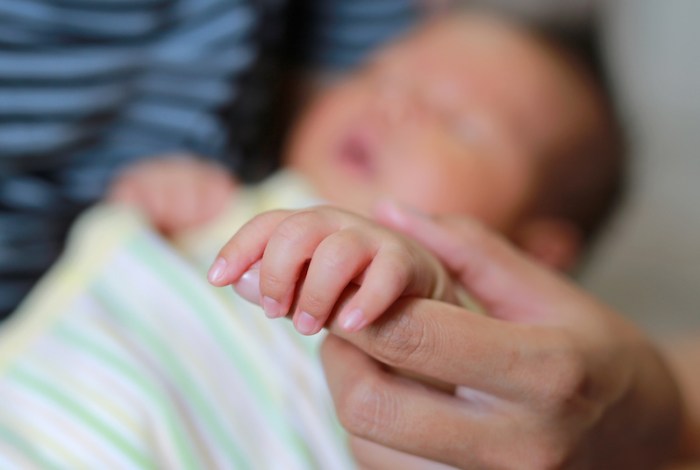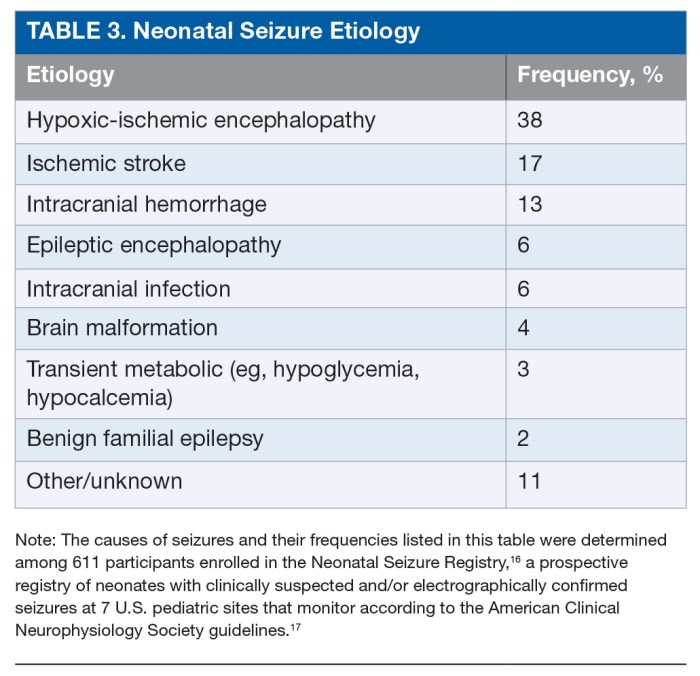Seizures finding to report for a 2-week-old newborn ati – Neonatal seizures, a critical concern in newborn healthcare, present unique challenges in diagnosis and management. This article delves into the intricacies of seizures in 2-week-old newborns, providing a comprehensive overview of their etiology, clinical manifestations, diagnostic evaluation, treatment options, and long-term outcomes.
Understanding the complexities of neonatal seizures is essential for healthcare professionals to ensure optimal care and improve the quality of life for affected infants.
Neonatal Seizures: Definition and Classification
Neonatal seizures are paroxysmal, involuntary movements or changes in behavior that occur in newborns, particularly within the first 2 weeks of life. These seizures can vary significantly in type and characteristics, leading to a classification system that helps guide diagnosis and management.
Neonatal seizures are classified into two main categories: early-onset seizures and late-onset seizures. Early-onset seizures occur within the first 24 hours of life and are often associated with hypoxic-ischemic encephalopathy or other acute perinatal events. Late-onset seizures, on the other hand, occur after the first 24 hours of life and are more commonly associated with metabolic disorders, infections, or genetic abnormalities.
Within these two categories, neonatal seizures can be further subclassified based on their clinical manifestations. Some common seizure types in newborns include:
- Tonic seizures: These seizures are characterized by sustained muscle contractions that can affect the entire body or specific muscle groups.
- Clonic seizures: These seizures involve rhythmic, jerking movements that can affect one or both sides of the body.
- Myoclonic seizures: These seizures are characterized by brief, involuntary muscle jerks that can affect the limbs, trunk, or face.
- Subtle seizures: These seizures may be difficult to detect and can manifest as changes in breathing, eye movements, or facial expressions.
Etiology of Seizures in 2-Week-Old Newborns

The causes of seizures in 2-week-old newborns can be diverse and complex. Some common etiologies include:
- Metabolic disorders:Hypoglycemia, hypocalcemia, and hypomagnesemia are common metabolic disorders that can lead to seizures in newborns.
- Infections:Meningitis, encephalitis, and sepsis are infectious conditions that can cause seizures in newborns.
- Genetic factors:Certain genetic disorders, such as inborn errors of metabolism and chromosomal abnormalities, can increase the risk of neonatal seizures.
- Hypoxic-ischemic encephalopathy:This condition, caused by a lack of oxygen and blood flow to the brain, can lead to seizures in newborns.
- Other factors:Prematurity, low birth weight, and maternal health conditions, such as preeclampsia and eclampsia, can also increase the risk of neonatal seizures.
Clinical Manifestations of Seizures in 2-Week-Old Newborns

The clinical manifestations of seizures in 2-week-old newborns can vary depending on the type and severity of the seizure. Some common signs and symptoms include:
- Tonic seizures:Sustained muscle contractions, often involving the arms, legs, and trunk.
- Clonic seizures:Rhythmic, jerking movements that can affect one or both sides of the body.
- Myoclonic seizures:Brief, involuntary muscle jerks that can affect the limbs, trunk, or face.
- Subtle seizures:Changes in breathing, eye movements, or facial expressions that may be difficult to detect.
- Apnea:Cessation of breathing for more than 20 seconds.
- Cyanotic episodes:Bluish discoloration of the skin or lips due to lack of oxygen.
Seizures in newborns can vary in duration, frequency, and severity. Some seizures may be brief and infrequent, while others may be prolonged and recurrent.
Diagnostic Evaluation of Neonatal Seizures: Seizures Finding To Report For A 2-week-old Newborn Ati

The diagnosis of neonatal seizures involves a thorough evaluation that includes:
- Physical examination:The physical examination can provide clues to the underlying cause of the seizures, such as signs of infection or metabolic disorders.
- Laboratory tests:Blood tests can help identify metabolic abnormalities, such as hypoglycemia or hypocalcemia, that may be causing the seizures.
- Imaging studies:Imaging studies, such as magnetic resonance imaging (MRI) or computed tomography (CT) scans, can help identify structural abnormalities or lesions in the brain that may be contributing to the seizures.
- Electroencephalography (EEG):EEG is a non-invasive test that records the electrical activity of the brain. It is essential for diagnosing and classifying neonatal seizures, as it can detect abnormal patterns of brain activity that are characteristic of different seizure types.
FAQ Section
What are the common causes of seizures in 2-week-old newborns?
Common causes include metabolic disorders (e.g., hypoglycemia, hypocalcemia), infections (e.g., meningitis, sepsis), and genetic factors (e.g., chromosomal abnormalities).
How are neonatal seizures diagnosed?
Diagnosis involves a thorough physical examination, laboratory tests, imaging studies (e.g., cranial ultrasound), and electroencephalography (EEG) to capture brain activity patterns.
What are the treatment options for neonatal seizures?
Treatment typically involves anticonvulsant medications to control seizures and supportive care to address underlying causes and prevent complications.
What is the prognosis for newborns with seizures?
Prognosis varies depending on the underlying cause, seizure severity, and timely intervention. Some newborns may experience long-term neurodevelopmental consequences, while others may have favorable outcomes.